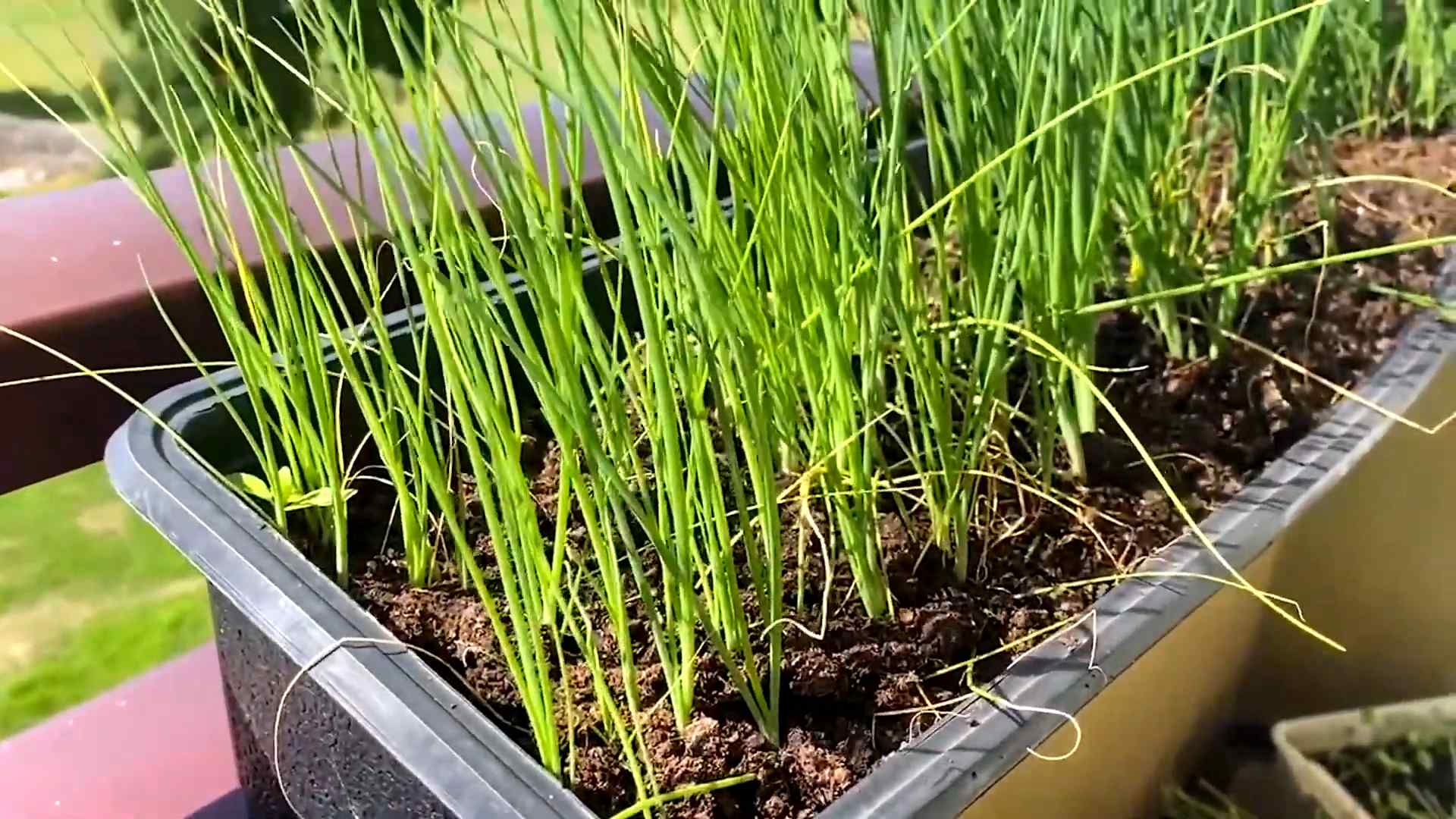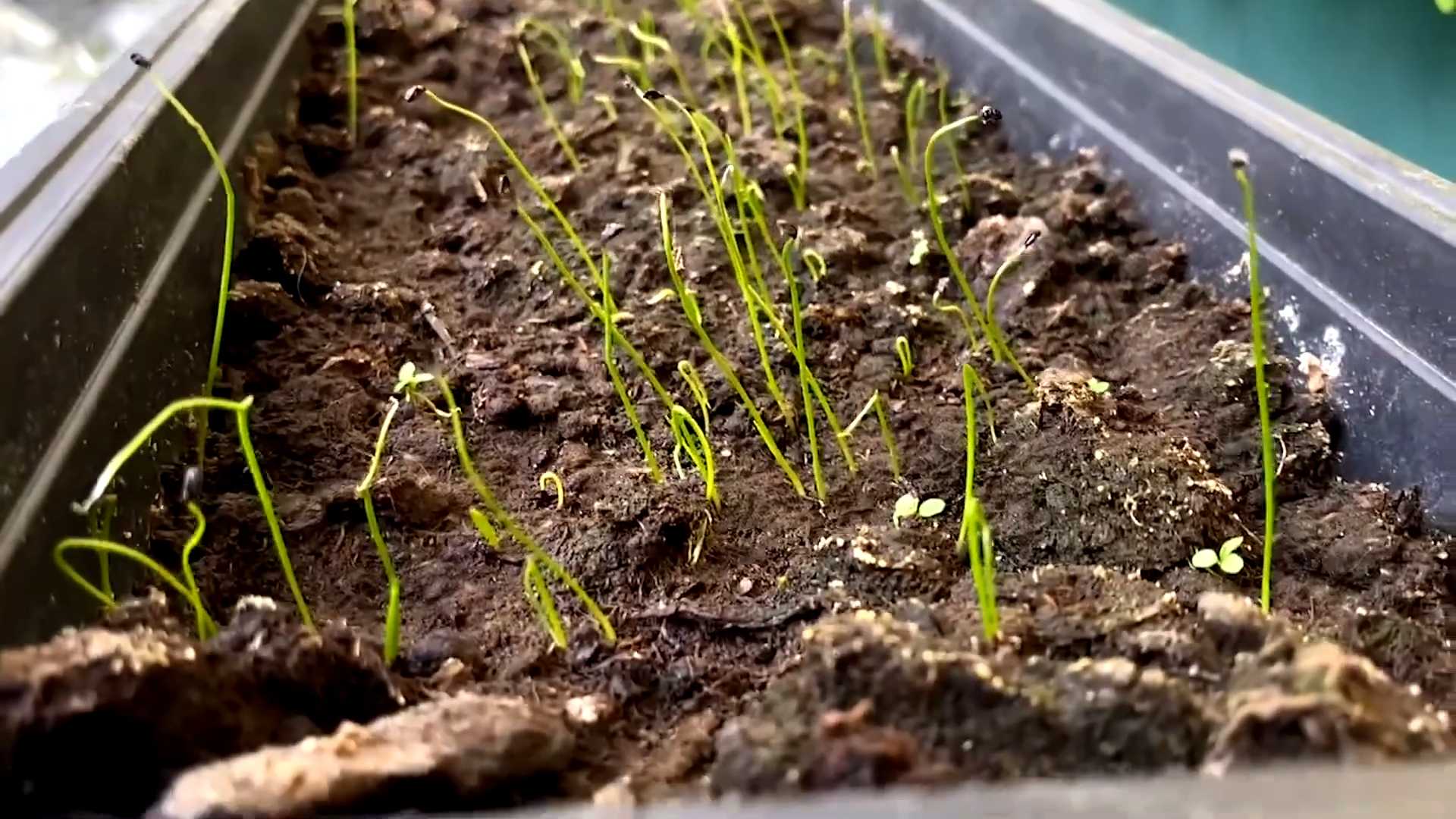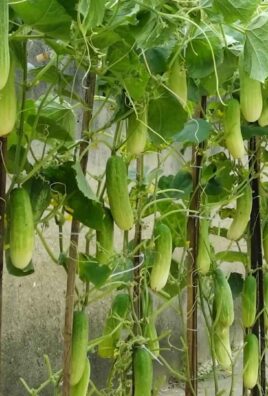Grow Chives Indoors? Absolutely! Imagine snipping fresh, flavorful chives right from your kitchen windowsill, adding a burst of oniony goodness to your meals year-round. No more sad, wilted herbs from the grocery store – just vibrant, homegrown chives at your fingertips. For centuries, chives have been a staple in gardens and kitchens worldwide, prized for their delicate flavor and ease of cultivation. From ancient Roman cuisine to modern-day culinary creations, these versatile herbs have added a touch of freshness to countless dishes.
But let’s face it, not everyone has a sprawling garden or the perfect outdoor climate to grow chives indoors successfully. That’s where these simple, yet effective DIY tricks come in! I’m going to share my secrets for cultivating thriving chives indoors, even if you have a black thumb. Whether you’re a seasoned gardener or a complete beginner, these tips will empower you to enjoy the taste of homegrown chives without ever stepping foot outside. Get ready to transform your kitchen into a mini herb garden and elevate your cooking with the freshest ingredients imaginable!

Growing Chives Indoors: A Beginner’s Guide
Hey there, fellow plant enthusiasts! Ever dreamt of snipping fresh chives right from your kitchen windowsill? Well, dream no more! Growing chives indoors is surprisingly easy, rewarding, and adds a touch of green (and delicious flavor!) to your home. I’m going to walk you through everything you need to know, from choosing the right container to harvesting your flavorful bounty. Let’s get started!
What You’ll Need
Before we dive into the nitty-gritty, let’s gather our supplies. Here’s a checklist of everything you’ll need to successfully grow chives indoors:
* **Chive Seeds or a Chive Plant:** You can start from seeds, which is more economical, or purchase a small chive plant from a nursery or garden center for faster results. I personally prefer starting from seeds; it’s so satisfying to watch them sprout!
* **A Container with Drainage Holes:** Choose a pot that’s at least 6 inches deep and wide. Good drainage is crucial to prevent root rot. Terra cotta pots are a great option as they allow the soil to breathe.
* **Potting Mix:** Use a high-quality potting mix that’s well-draining. Avoid using garden soil, as it can compact and hinder drainage. I like to use a mix specifically formulated for herbs.
* **Watering Can or Spray Bottle:** For gentle watering.
* **Grow Light (Optional but Recommended):** While chives can tolerate some shade, they thrive with plenty of light. A grow light will ensure they get enough light, especially during the winter months.
* **Scissors or Kitchen Shears:** For harvesting your chives.
* **Small Shovel or Trowel:** For planting.
Starting from Seeds: A Step-by-Step Guide
Okay, so you’ve decided to embark on the seed-starting journey! Awesome! Here’s how to do it:
1. **Prepare Your Container:** Fill your chosen container with potting mix, leaving about an inch of space at the top. Gently pat down the soil to create a firm surface.
2. **Sow the Seeds:** Sprinkle the chive seeds evenly over the surface of the soil. You don’t need to bury them too deep; just lightly press them into the soil. A good rule of thumb is to plant them about ¼ inch deep.
3. **Water Gently:** Use a watering can or spray bottle to gently moisten the soil. Avoid overwatering, as this can cause the seeds to rot. The soil should be damp but not soggy.
4. **Cover the Container (Optional):** To create a humid environment that promotes germination, you can cover the container with a plastic bag or clear plastic wrap. Make sure to poke a few holes in the plastic for ventilation.
5. **Place in a Warm Location:** Place the container in a warm location, ideally around 70-75°F (21-24°C). A sunny windowsill or a spot under a grow light works well.
6. **Monitor and Water:** Keep the soil consistently moist but not waterlogged. Check the soil moisture daily and water as needed.
7. **Remove the Cover:** Once the seedlings emerge (usually within 7-14 days), remove the plastic cover.
8. **Thin the Seedlings (If Necessary):** If the seedlings are too crowded, thin them out by gently snipping off the weaker ones at the soil line. This will give the remaining seedlings more room to grow. Aim for about 1-2 inches between plants.
Transplanting a Chive Plant
If you’ve opted to purchase a chive plant, the process is even simpler!
1. **Prepare Your Container:** Fill your chosen container with potting mix, leaving about an inch of space at the top.
2. **Gently Remove the Plant:** Carefully remove the chive plant from its original container. Gently loosen the roots if they are tightly bound.
3. **Plant the Chives:** Dig a hole in the potting mix large enough to accommodate the root ball of the chive plant. Place the plant in the hole and gently backfill with potting mix.
4. **Water Thoroughly:** Water the plant thoroughly after planting.
5. **Place in a Sunny Location:** Place the container in a sunny location or under a grow light.
Caring for Your Indoor Chives
Now that your chives are planted, it’s time to provide them with the care they need to thrive.
* **Light:** Chives need at least 6-8 hours of sunlight per day. If you don’t have a sunny windowsill, a grow light is a great investment.
* **Watering:** Water your chives regularly, keeping the soil consistently moist but not waterlogged. Allow the top inch of soil to dry out between waterings. Overwatering can lead to root rot.
* **Fertilizing:** Feed your chives with a balanced liquid fertilizer every 2-4 weeks during the growing season (spring and summer). Follow the instructions on the fertilizer label.
* **Temperature:** Chives prefer temperatures between 60-70°F (15-21°C).
* **Humidity:** Chives don’t require high humidity, but they appreciate a slightly humid environment. You can increase humidity by placing a tray of water near the plant or using a humidifier.
* **Pruning:** Regular pruning encourages bushier growth. Simply snip off the tips of the chives with scissors or kitchen shears.
Harvesting Your Chives
The best part! You can start harvesting your chives once they are about 6 inches tall.
1. **Use Sharp Scissors:** Use sharp scissors or kitchen shears to snip off the chives about 1-2 inches above the soil line.
2. **Harvest Regularly:** Harvest your chives regularly to encourage new growth.
3. **Don’t Over-Harvest:** Avoid harvesting more than one-third of the plant at a time.
4. **Enjoy!** Use your freshly harvested chives to add flavor to soups, salads, omelets, dips, and more!
Troubleshooting
Even with the best care, you might encounter a few challenges along the way. Here are some common problems and how to address them:
* **Yellowing Leaves:** Yellowing leaves can be a sign of overwatering, underwatering, or nutrient deficiency. Check the soil moisture and adjust your watering accordingly. If the soil is consistently moist, reduce watering. If the soil is dry, water more frequently. You may also need to fertilize your chives.
* **Leggy Growth:** Leggy growth (long, spindly stems) is usually a sign of insufficient light. Move your chives to a sunnier location or provide them with a grow light.
* **Pests:** Chives are generally pest-resistant, but they can occasionally be affected by aphids or spider mites. If you notice pests, try spraying the plants with a strong stream of water or using an insecticidal soap.
* **Root Rot:** Root rot is caused by overwatering and poor drainage. Make sure your container has drainage holes and that you’re not overwatering your chives. If you suspect root rot, repot the plant in fresh potting mix.
Extending the Harvest
Want to keep those chives coming all year round? Here are a few tips:
* **Succession Planting:** Sow new seeds every few weeks to ensure a continuous supply of chives.
* **Divide the Plant:** Every year or two, you can divide your chive plant to create new plants. Simply dig up the plant and gently separate the roots into smaller clumps. Replant the clumps in separate containers.
* **Overwintering:** If you live in a cold climate, you can overwinter your chives indoors. Before the first frost, bring your chive plant indoors and place it in a sunny location or under a grow light. Reduce watering during the winter months.
Enjoy Your Homegrown Chives!
Growing chives indoors is a simple and rewarding way to add fresh flavor to your meals. With a little care and attention, you can enjoy a continuous supply of chives all year round. Happy gardening! I hope you found this guide helpful. Now go forth and grow some chives!

Conclusion
So, there you have it! Growing chives indoors is not just a possibility; it’s a remarkably simple and rewarding endeavor that can transform your culinary experience. Forget those sad, wilted bunches from the grocery store. Imagine snipping fresh, vibrant chives right from your windowsill, adding a burst of flavor to your omelets, salads, soups, and countless other dishes. This DIY trick is a game-changer for anyone who values fresh ingredients and the satisfaction of growing their own food, even in a limited space.
Why is this a must-try? Because it offers a continuous supply of fresh chives, regardless of the season. No more last-minute trips to the store or settling for dried herbs when you crave that delicate oniony flavor. It’s also incredibly cost-effective. A single packet of chive seeds or a small transplant can provide you with months, even years, of fresh herbs. Plus, it’s a fantastic way to add a touch of green to your home and connect with nature, even if you don’t have a garden.
But the beauty of growing chives indoors lies in its adaptability. Feel free to experiment with different varieties. Garlic chives, with their subtle garlic flavor, are a fantastic alternative. You can also try growing them in different types of containers, from repurposed yogurt cups to stylish terracotta pots. Just ensure adequate drainage. Consider using a self-watering planter for even easier maintenance.
For a fun variation, try companion planting. Chives are known to deter pests, so placing them near other indoor herbs like basil or rosemary can be beneficial. You can even grow them alongside certain vegetables, like tomatoes, if you have enough space and light.
Ultimately, the best way to discover the joys of growing chives indoors is to simply give it a try. Don’t be intimidated if you’ve never grown herbs before. Chives are incredibly forgiving and require minimal effort. Start with a small pot, follow the basic guidelines we’ve discussed, and watch your chives thrive.
We are confident that you’ll be amazed at how easy and rewarding it is to have a constant supply of fresh chives at your fingertips. So, grab a pot, some soil, and some chive seeds or a transplant, and get started today!
And most importantly, we want to hear about your experience! Share your tips, tricks, and photos of your indoor chive gardens in the comments below. Let’s create a community of indoor herb enthusiasts and inspire others to discover the joys of growing their own food. What are you waiting for? Start growing chives indoors today!
Frequently Asked Questions (FAQ)
1. What kind of soil is best for growing chives indoors?
The best soil for growing chives indoors is a well-draining potting mix. Avoid using garden soil, as it can become compacted and doesn’t provide adequate drainage for container gardening. Look for a potting mix specifically formulated for herbs or vegetables. A mix containing peat moss, perlite, and vermiculite is ideal. You can also amend your potting mix with compost to provide extra nutrients.
2. How much sunlight do chives need when grown indoors?
Chives need at least 6 hours of direct sunlight per day to thrive indoors. A south-facing window is usually the best option. If you don’t have a sunny window, you can supplement with a grow light. Place the grow light a few inches above the chives and keep it on for 12-14 hours per day. Insufficient sunlight can lead to leggy growth and reduced flavor.
3. How often should I water my indoor chives?
Water your chives when the top inch of soil feels dry to the touch. Avoid overwatering, as this can lead to root rot. Ensure your pot has drainage holes to allow excess water to escape. During the warmer months, you may need to water more frequently than in the cooler months. Check the soil moisture regularly and adjust your watering schedule accordingly.
4. Do I need to fertilize my indoor chives?
Yes, chives benefit from regular fertilization, especially when grown in containers. Use a balanced liquid fertilizer diluted to half strength every 2-3 weeks during the growing season (spring and summer). Avoid over-fertilizing, as this can burn the roots. You can also use a slow-release fertilizer at the time of planting.
5. How do I harvest chives without killing the plant?
The key to harvesting chives without harming the plant is to cut them properly. Use sharp scissors or pruning shears to snip the chives about 1-2 inches above the soil line. Avoid cutting all the chives at once, as this can weaken the plant. Instead, harvest about one-third of the plant at a time. This will encourage new growth and ensure a continuous supply of fresh chives.
6. Can I grow chives from seed indoors?
Yes, you can easily grow chives from seed indoors. Start the seeds indoors 6-8 weeks before the last expected frost. Sow the seeds about ¼ inch deep in a seed-starting mix. Keep the soil moist and warm (around 70-75°F). Once the seedlings emerge, provide them with plenty of light. Transplant them into individual pots when they are a few inches tall.
7. My chives are turning yellow. What could be the problem?
Yellowing chives can be caused by several factors, including overwatering, underwatering, nutrient deficiency, or insufficient sunlight. Check the soil moisture and adjust your watering schedule accordingly. Ensure your chives are receiving adequate sunlight. If the problem persists, try fertilizing with a balanced liquid fertilizer.
8. Are chives susceptible to pests or diseases when grown indoors?
Chives are generally resistant to pests and diseases when grown indoors. However, they can occasionally be affected by aphids or spider mites. If you notice any pests, try washing them off with a strong stream of water. You can also use insecticidal soap or neem oil to control infestations. Ensure good air circulation to prevent fungal diseases.
9. Can I transplant outdoor chives indoors?
Yes, you can transplant outdoor chives indoors, but it’s best to do so in the fall before the first frost. Dig up the chives carefully, ensuring you get as much of the root system as possible. Plant them in a pot with well-draining potting mix. Water thoroughly and place them in a sunny location. They may experience some transplant shock initially, but they should recover quickly.
10. How long will my indoor chives last?
With proper care, your indoor chives can last for several years. They may go dormant in the winter, but they will typically regrow in the spring. To prolong their lifespan, divide the clumps every 2-3 years to prevent overcrowding. This will also help to rejuvenate the plant and encourage new growth.





Leave a Comment